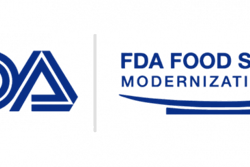
Headlines such as “Many sickened by foodborne illness linked to lettuce” and “Bagged salad recall” tend to attract extensive media coverage. Following these reports, the search to find out who is responsible for the illnesses begins. Did something go wrong when it was being grown? Was it properly transported, or did it spoil on the shelf? No matter the case, the outbreak was a danger to consumers, and that’s not the kind of publicity any business wants.
Due to the rising number of foodborne illnesses in the early 2000s, Congress decided it was time to make improvements. The new regulations set higher standards for handling food throughout the supply chain, and since June 2017, companies transporting food have been required to comply with the Food Safety Modernization Act (FSMA). This presented challenges such as increased accountability, improved monitoring of the supply chain, quicker adoption of best practices and more collaboration within the industry.
For the transportation and logistics industry, this meant they had to find new ways to ensure trucking companies were compliant with the newly formed laws. There are certain steps that shippers and carriers can take to guarantee they are following regulations, and there are ways to improve business operations, such as using a solution to improve supply chain monitoring and relations with carriers. These steps can go a long way in enhancing the supply chain and preventing foodborne illness outbreaks due to poor or improper transportation.
Log in to view the full article
Headlines such as “Many sickened by foodborne illness linked to lettuce” and “Bagged salad recall” tend to attract extensive media coverage. Following these reports, the search to find out who is responsible for the illnesses begins. Did something go wrong when it was being grown? Was it properly transported, or did it spoil on the shelf? No matter the case, the outbreak was a danger to consumers, and that’s not the kind of publicity any business wants.
Due to the rising number of foodborne illnesses in the early 2000s, Congress decided it was time to make improvements. The new regulations set higher standards for handling food throughout the supply chain, and since June 2017, companies transporting food have been required to comply with the Food Safety Modernization Act (FSMA). This presented challenges such as increased accountability, improved monitoring of the supply chain, quicker adoption of best practices and more collaboration within the industry.
For the transportation and logistics industry, this meant they had to find new ways to ensure trucking companies were compliant with the newly formed laws. There are certain steps that shippers and carriers can take to guarantee they are following regulations, and there are ways to improve business operations, such as using a solution to improve supply chain monitoring and relations with carriers. These steps can go a long way in enhancing the supply chain and preventing foodborne illness outbreaks due to poor or improper transportation.
Advancing Food Safety
FSMA is transforming the nation’s food safety system by shifting the focus from responding to foodborne illness to preventing it. Congress passed FSMA in response to dramatic changes in the global food supply chain and in our understanding of foodborne illness and its consequences, including the realization that preventable foodborne illness is both a significant public health problem and a threat to the economic well-being of the food industry.
FSMA was signed into law by President Obama in 2011, but it wasn’t until June 2016 when the most recent amendment affecting transportation was finalized, with it initially going into effect in 2017. The law became the first major legislation addressing food safety since 1938; it was deemed necessary due to several foodborne illnesses during the first decade of the 2000s. One of the main reasons the legislation passed through Congress so quickly was due to the support and sponsorship of the Grocery Manufacturers Association. The outspoken organization was aware of how much money illnesses cost the food industry—billions of dollars in recalls, lost sales, insurance fees and legal expenses.
But that is not to say the transportation industry didn’t have regulations in place already. In 2005, the Sanitary Food Transport Act (SFTA) was enacted, and established the groundwork for shippers and carriers keeping records on the transportation of food. It required the U.S. Food and Drug Administration (FDA) to determine sanitary transportation practices to ensure that food (including animal feed) transported by motor vehicle or rail was not transported under conditions that may adulterate the food. And, while the SFTA stated that trailers should be cleaned, there were no guidelines on how that process should be done or how often. The new FSMA was intended to supplement the SFTA, not replace it.
The FDA finalized five main rules to implement FSMA, recognizing that ensuring the safety of the food supply is a shared responsibility among many different areas in the global supply chain for both human and animal food. The rules are intended to define specific actions that must be taken in each of these areas to prevent contamination. While there are exceptions, such as the exclusion of small farms, ranches and local processors from federal oversight, the trucking industry has to follow strict regulations to ensure that food is properly handled throughout the transportation process. This includes:
- Temperature control/tracking: For refrigerated products, every storage compartment must be pre-cooled and have a temperature-monitoring device. Shippers must also define temperature specifications to be met throughout transportation.
- Temperature certification/data exchange: A log of temperature conditions for the duration of the transportation must be provided to the receiver/shipper by the carrier upon request.
- Cleanliness: Vehicles must be maintained in a sanitary condition and are subject to inspection. Loading/unloading stations must have hand-washing facilities.
- Training: Carriers must provide basic sanitary transportation practice training to their personnel.
- Data retention: All records must be stored for a period of 12 months.
While transportation is just one aspect of the supply chain in the food and beverage industry, it is an area that is just as important as any other. Considering that transportation is one-third of the supply chain—from farms to stores and restaurants before reaching the end consumer—all parties are tasked with working together under the regulations outlined by FSMA to ensure that food reaches consumers in a safe manner and to prevent foodborne illnesses.
Adoption Challenges
New regulations mean changing outdated operations, and the trucking industry has shown that it struggles to adopt new practices. One challenge that has plagued the industry for years is the lack of collaboration between shippers and carriers. This is a constant battle when food transportation is involved, because whenever a widespread foodborne illness outbreak occurs and points back to the transportation of the product, shippers and carriers consistently try to shift the blame. When neither party is working together, an outbreak is more likely to take place.
Another challenge that the trucking industry faces is adhering to the food product transportation parameters that are outlined in a shipper/carrier contract. Most foods have certain transportation guidelines, largely involving transport temperature range. By law, shippers are required to monitor the condition of their product as it travels through the supply chain until it reaches the customer. However, some carriers don’t have the systems in place to track trailer temperature conditions, which creates further division between shippers and carriers.
The main challenge of FSMA compliance is ensuring that no freight is lost to foodborne illnesses by making sure that it is loaded correctly and not potentially contaminated during transportation. If the regulations aren’t followed, the FDA has three primary mechanisms for enforcement when it comes to imposing direct penalties for non-compliance: re-inspection fees totaling about $225 per hour, product recalls or suspension of facility registration. These consequences can be disastrous for shippers and carriers alike, not only because they lose revenue, but also because it hurts their reputation during future transactions.
Before freight visibility solutions were available, shippers were unaware of what was going on while a shipment was in the hands of the carrier. Consequently, if a foodborne illness was linked to the transportation of the food or beverage, the shippers would automatically blame the carrier. But the addition of FSMA, along with the advent of visibility solutions, has shifted the burden of responsibility back to the shippers. They are required to know how their product is handled at all times within the supply chain.
However, more is at stake than knowing who is responsible for a foodborne illness, because sometimes it isn’t linked to the transportation process. Both shippers and carriers should be aware that foodborne illnesses cost the United States an estimated $152 billion per year in healthcare, workplace and other economic losses, according to a report published by the Produce Safety Project.
When a foodborne illness is detected, all of that specific product is lost, which sends ripples down the supply chain. Shippers not only lose the potential earnings from product sales, but they also must discard any of the merchandise that is still in transit. An added economic loss occurs when their goods aren’t on the shelf, and a consumer chooses the competitor’s product. They may continue to purchase the competitor’s merchandise even after the shipper’s product is deemed safe, which results in the continuous loss of customers.
If the illness is linked to the transportation process, the carrier is hit hard. They will lose the earnings from the load and have to pay insurance claims. At the same time, shippers might choose to use a different carrier the next time, which impacts future revenue.
The company’s brand image absorbs the most impact of being linked to a foodborne illness. For shippers, there are plenty of competing products on the market that consumers can choose rather than returning to their product. Carriers run the risk of losing drivers to competing businesses that haven’t been linked to an outbreak, which, due to driver shortage, can be detrimental to a carrier’s business.
Applying Technology
The main answer to these challenges is to implement a freight visibility solution. Prior to the institution of FSMA, data tracking was performed using manual processes or inefficient software solutions. Often, there were discrepancies between shipper and carrier data, which made it more difficult for authorities to determine who was at fault when a foodborne illness was caused by improper transportation. But with a third-party solutions provider, shippers and carriers can accurately track freight, and both parties are more inclined to accept information from a third-party provider because it is unaltered.
A freight visibility solution can track a shipment’s location as the carrier travels to the destination. It can also monitor the temperature within the trailer to ensure that the product is stored in the proper temperature range during transport. An added benefit is that both shippers and carriers can see the clean data, which ensures that shipments arrive to their destinations according to the standards set by FSMA.
Most importantly, both the shipper and carrier are required to meet the standards of food and beverage transportation. When guidelines aren’t met, both lose out on potential earnings and may face heavy fines, especially when a foodborne illness is linked directly to the transportation process. FSMA regulations that a freight visibility solution is unable to monitor and which human error can factor into include:
- The transport trailer must be designed and made from material that can be adequately cleaned and sanitized. One of the concerns was that “adequately cleaned and sanitized” was not clearly defined. Considering the quantity of the requirements, it was up to the shipper to make that determination.
- Product must be maintained in a sanitary condition that will ensure overall food safety. For instance, broken pallets that could puncture the product might not be allowed in trailers.
- Product must be appropriately stored to prevent pests or contamination that could result in food becoming unsafe.
In the segmented atmosphere of the transportation and logistics industry, shippers and carriers would take any action necessary to make the best decision for their business. By using a third-party solutions vendor, the two can monitor data in the system and work closely to ensure that the transportation of the food and beverages follows FSMA regulations. When shippers and carriers work together and share accurate information, the likelihood of lost freight decreases.
The rise of freight visibility solutions has enabled shippers and carriers to share data more openly and freely through trusted, third-party vendors. Solutions like those offered by 10-4 Systems enable shippers and carriers to monitor their freight from the time it leaves the warehouse to the time it reaches the customer.
By providing insight into temperature control and location tracking, shippers and carriers can ensure that food and beverage products are transported according to FSMA regulations and that both parties are following the rules outlined by the contract.

















